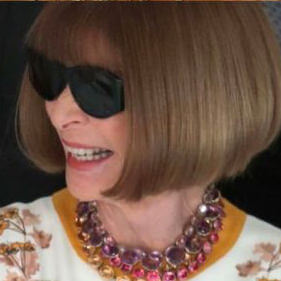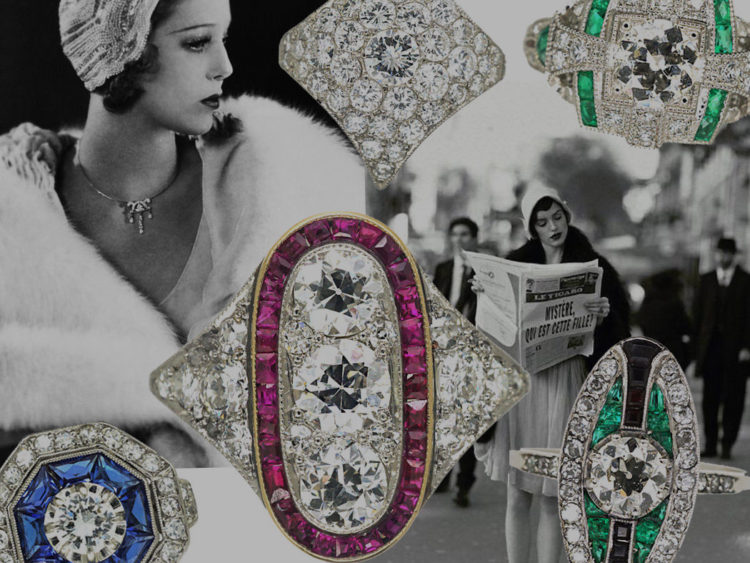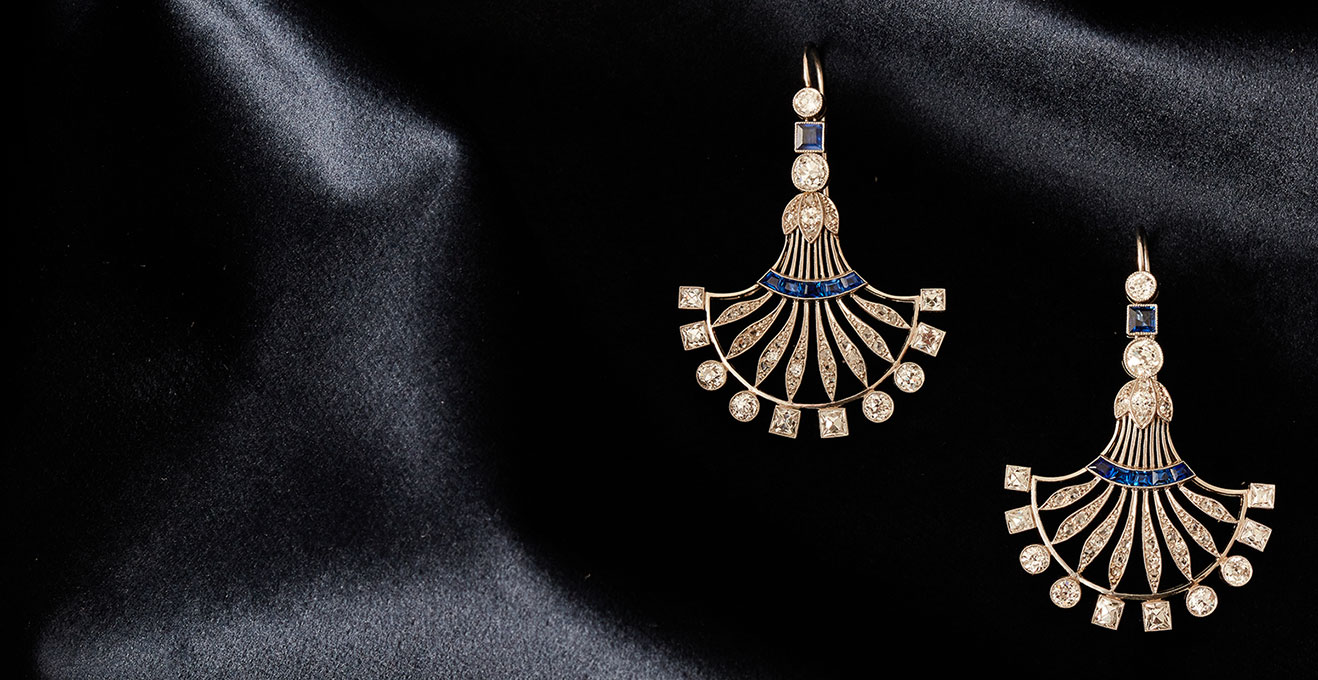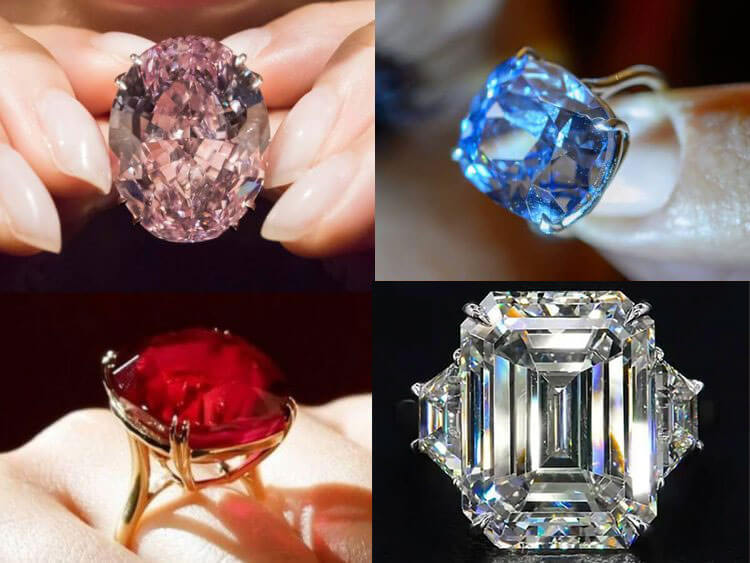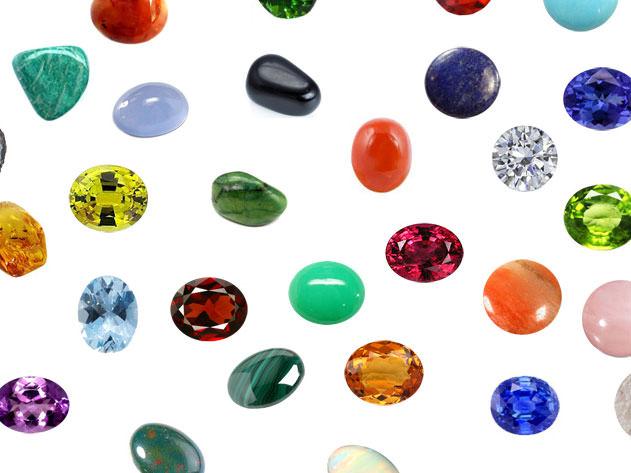-

Your Shopping Bag is empty
Jewellery of the Aristocracy: Famous Royal and Noble Collections Through History
From ancient civilizations to the modern-day royal courts, jewellery has always been a symbol of wealth, power, and authority among the aristocracy. These treasures, found in royal and aristocratic jewellery collections, have been passed down through generations, carrying the stories of dynasties, conquests, marriages, and political alliances. The history of royal and noble jewellery is rich with gems that defined not only personal styles but entire eras, while also being intertwined with diplomacy, romance, and politics.
This expanded exploration of royal and noble jewellery collections through history delves into the legacy of these priceless treasures, their significance, and the role they played in shaping aristocratic societies over the centuries.
Ancient Civilizations: Jewellery as Divine Authority
The tradition of aristocratic jewellery began in the ancient world, where rulers, often seen as divine, wore jewellery to symbolize their heavenly authority. In ancient Egypt, pharaohs were buried with lavish jewellery meant to protect them in the afterlife and to signify their godlike status on earth. Among the most famous collections is that of Tutankhamun, whose tomb, discovered in 1922 by Howard Carter and his benefactor Lord Carnarvon, contained an extraordinary array of gold and jewelled artefacts. His iconic gold burial mask, inlaid with turquoise, lapis lazuli, and carnelian, was designed not only for beauty but also for spiritual protection.

The jewellery of ancient Egypt was more than just adornment—it served spiritual purposes, offering protection and symbolizing power. Cleopatra, Egypt’s last pharaoh, was legendary for her pearls and emeralds. These jewels were not just personal accessories but diplomatic tools. Cleopatra’s emeralds, in particular, played a significant role in captivating Julius Caesar and Mark Antony, two of Rome’s most powerful figures, further intertwining jewellery with political influence.

In ancient Rome, jewellery was similarly an emblem of status, and the aristocracy adorned themselves with gold, gemstones, and intricate designs. Wealthy Romans, including emperors and empresses, flaunted lavish rings, necklaces, and brooches made of gold, often set with precious stones like emeralds and amethysts. Emperor Augustus was known for his fine collection, but it was Cleopatra’s romance with Mark Antony that fuelled Roman fascination with jewellery, sparking a desire for pearls and gemstones.
Medieval Europe: Jewellery, Faith, and Heraldry
During the Middle Ages, the aristocracy’s use of jewellery took on religious and symbolic meaning. Gold crosses, reliquaries, and amulets adorned with gemstones were worn by monarchs and nobles to express their piety and divine right to rule. These jewels not only reflected the wealth of their owners but also served as sacred objects believed to offer spiritual protection.
One of the most significant examples is Charlemagne’s Crown, a symbol of imperial power in the Holy Roman Empire. Adorned with sapphires, emeralds, and amethysts, this crown symbolized the ruler’s divine right, closely linking monarchy and religion. Jewellery was often exchanged between royal families and the Church as gifts, securing political alliances and reinforcing the monarch’s position.

(right) A US soldier wearing the crown, found in a cave in Siegen, Germany, 1945 (colorized WWII photo)
Heraldic jewelry also became popular during this period, with noble families using rings, brooches, and pendants to display their coats of arms. These items served as visual symbols of loyalty and family honor. During the Crusades, European knights brought back gemstones like rubies and diamonds from the Middle East, further enriching the collections of the European aristocracy.
The Renaissance: The Rise of Art and Opulence
The Renaissance, with its focus on art, culture, and individual expression, saw an explosion of jewellery craftsmanship. Wealthy families, particularly in Italy, France, and England, used jewellery to express their power, taste, and influence. The Medici family of Florence was perhaps the most famous patrons of jewellery, commissioning some of the finest pieces from Italian goldsmiths and jewellers. The Medicis collected extravagant brooches, rings, and necklaces set with diamonds, emeralds, and rubies, reflecting their immense political power and their role as cultural benefactors.
Lorenzo de’ Medici, also known as “Lorenzo the Magnificent,” was a passionate collector of jewellery, and his court was renowned for its artistic splendour. Jewellery became a way for nobles to showcase their taste and sophistication, with pieces inspired by classical mythology and Renaissance art. At the same time, the Borgia family, known for their political intrigues, also amassed a significant collection of jewels. Lucrezia Borgia, one of the most famous women of the Renaissance, was known for her exquisite collection of pearls, rubies, and emeralds, symbols of her family’s influence and wealth.


Renaissance queens, such as Mary, Queen of Scots, and Catherine de’ Medici, also used jewellery as political tools. Catherine’s collection was vast and influential—she possessed diamonds, rubies, and pearls of extraordinary value, all used to assert her authority as Queen of France and as a central figure in European politics. These jewels, with their rich history, remain some of the most coveted pieces of Renaissance art.

(right) Portrait of Catherine de’ Medici, Queen of France, attributed to Germain Le Mannier, painted between 1547 and 1559 (Louvre Museum, Paris)
The Baroque and Rococo Periods: A Time of Extravagance
The Baroque period of the 17th century was an era of excess, and no court was more opulent than that of Louis XIV of France, the “Sun King.” Louis XIV used jewellery to showcase his absolute power, and the French Crown Jewels became the most splendid collection in Europe. Among the most famous pieces was the Blue Diamond of the Crown, a 69-carat diamond that eventually became part of the legendary Hope Diamond – the largest blue diamond in the world. Louis XIV adorned himself with diamonds, emeralds, rubies, and sapphires, making Versailles a glittering showcase of royal splendour.

(middle) Jean-Baptiste Tavernier’s sketch of the original Blue Diamond; The Hope Diamond in its current form, after being turned into a pendant by Harry Winston (Smithsonian National Museum of Natural History in Washington DC)
(right) Portrait of Louis XIV, by Hyacinthe Rigaud, 1701 (Louvre Museum, Paris)
Jewellery during this period became more elaborate, with larger stones and intricate settings. The courtiers of Louis XIV, eager to gain favour, also invested in lavish pieces, making the French court the epicentre of aristocratic fashion. Diamonds, in particular, became the stone of choice for European monarchs, and jewellers like Jean-Baptiste Tavernier a significant role in bringing large diamonds from India to Europe. In fact, it was Tavernier who allegedly stole the 115.16-carat blue diamond from a Hindu statue, where it was serving as one of the eyes, and it has remained cursed ever since.
In England, the Stuart monarchs were equally fond of jewels. Queen Mary II and her sister, Queen Anne, possessed impressive collections of diamond tiaras, brooches, and necklaces, which they wore to symbolize their royal power.

(right) Queen Anne, studio of John Closterman, circa 1702
both © National Portrait Gallery
Jewellery was a central feature of royal portraiture during this time, with artists like Anthony van Dyck capturing the splendour of noblewomen in their finest jewels.
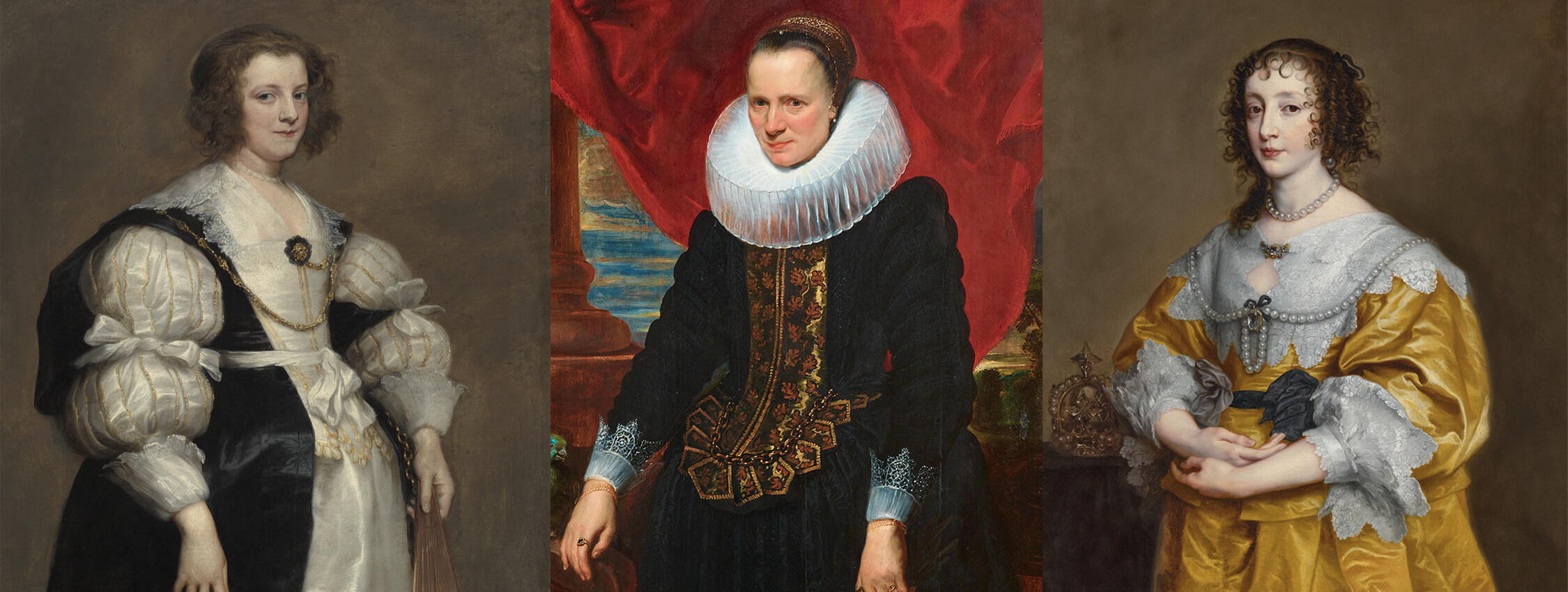
(left to right)
Lady with a Fan, c. 1628 (National Gallery of Art, Washington DC)
Portrait of a Woman with a Parrot, by Anthony van Dyck, 1635 (Museo Nacional del Prado, Madrid)
Queen Henrietta Maria, 1636 (The The Metropolitan Museum of Art, New York)
The Rococo period that followed Baroque introduced lighter, more whimsical designs. Jewellery became more delicate, with floral motifs and flowing, asymmetrical patterns. Diamonds and pearls were still favored, but they were arranged in more intricate, playful designs, reflecting the Rococo style’s emphasis on elegance and grace.
The British Royal Collection: Legacy of Victorian Opulence
The 19th century, particularly during the reign of Queen Victoria, marked the beginning of the modern era of royal jewellery. Queen Victoria was a passionate collector, and her personal style significantly influenced the jewellery trends of her time. One of her most iconic pieces was her engagement ring, shaped like a serpent—a symbol of eternal love. Victoria’s love for Prince Albert also inspired the famous Albert Brooch, a large sapphire surrounded by diamonds.

Portrait of Queen Victoria, by Alexander Melville, 1845
Queen Victoria’s Emerald & Gold Snake Engagement Ring
Queen Victoria on her Diamond Jubilee 22 June, 1897 (Photo by © Hulton-Deutsch Collection/CORBIS/Corbis via Getty Images)

After Albert’s death in 1861, Queen Victoria entered a period of mourning, during which she wore mourning jewellery made from jet and onyx. These pieces were designed to reflect her grief, yet they still conveyed her status as queen. Victoria’s mourning jewellery set a trend for black jewellery, which became popular among the aristocracy during periods of mourning.
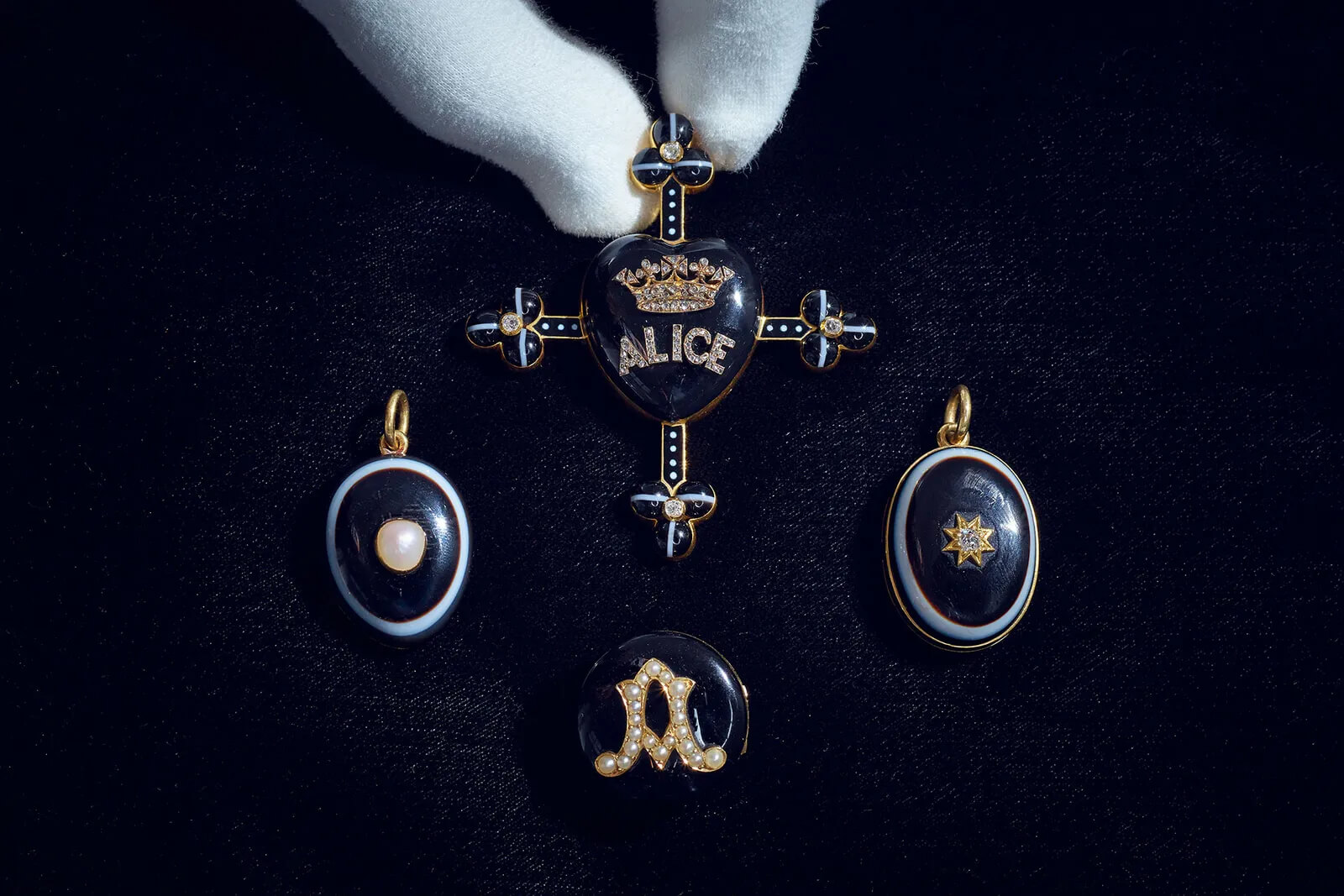
-
 Victorian 18ct Gold, Black Enamel & Pearl Pendant with Locket & Coronet on the Reverse
Victorian 18ct Gold, Black Enamel & Pearl Pendant with Locket & Coronet on the Reverse -
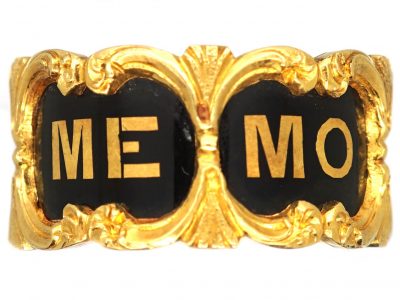 Victorian 18ct Gold & Black Enamel Mourning Ring
Victorian 18ct Gold & Black Enamel Mourning Ring -
 Victorian 18ct Gold & Black Enamel Ring with a Diamond Set Forget Me Not Flower
Victorian 18ct Gold & Black Enamel Ring with a Diamond Set Forget Me Not Flower -
 Victorian 18ct Gold & Black Enamel Mourning Ring
Victorian 18ct Gold & Black Enamel Mourning Ring -
 Victorian 18ct Gold, Black Enamel & Diamond Mourning Ring
Victorian 18ct Gold, Black Enamel & Diamond Mourning Ring -
Product on sale
 Victorian 15ct Gold Locket with Onyx, Rose Diamond & Pearl Flower Detail
Victorian 15ct Gold Locket with Onyx, Rose Diamond & Pearl Flower Detail
The British Royal Collection also includes some of the world’s most famous diamonds. The Koh-i-Noor Diamond, presented to Queen Victoria in 1850, remains one of the most controversial gems in history. This massive diamond, believed to bring misfortune to any male wearer, was passed down through Indian rulers before ending up in British hands. It now forms part of the Crown Jewels, set into the Queen Mother’s Crown.

(bottom) The crown on the Queen Mother’s lies on her coffin as it passes into Whitehall during the ceremonial procession at her funeral, March 30, 2002
(right) Queen Camilla wearing the crown at the Coronation of King Charles and The Queen Consort, May 6, 2023
Another highlight of the British collection is the Cullinan Diamond, the largest diamond ever found. Discovered in South Africa in 1905, the Cullinan was cut into several pieces, with the largest, the Great Star of Africa, set in the Sceptre with the Cross, and another large piece placed in the Imperial State Crown. These diamonds remain central pieces in British coronation regalia.

(right) The Crown Jewels at the Tower of London
The Russian Romanovs: Imperial Splendor and Fabergé
The jewellery collection of the Romanovs, Russia’s ruling dynasty until the Russian Revolution, was one of the most extravagant in history. The Romanovs were known for their love of opulent jewellery, and their collection included everything from tiaras and necklaces to jewelled eggs created by the famed jeweller Carl Fabergé.
One of the most iconic pieces is the Imperial Crown of Russia, created for Catherine the Great in 1762. This stunning crown features thousands of diamonds, including a massive red spinel, and symbolizes the grandeur of the Russian monarchy. The Romanovs’ love for diamonds and coloured gemstones was unparalleled, with emeralds, sapphires, and rubies adorning many of their most famous pieces.

The Romanovs are perhaps most famous for their collection of Fabergé eggs, which were commissioned by Tsar Alexander III and Nicholas II as Easter gifts for their wives and mothers. These jewelled eggs, often containing miniature surprises like golden carriages or tiny portraits, are masterpieces of jewellery craftsmanship. Sadly, the Russian Revolution led to the downfall of the Romanov dynasty, and many of their jewels were either sold off or disappeared.

20th Century and Beyond: Royal Jewels in the Modern Age
As the world moved into the 20th century, royal families continued to maintain their vast jewellery collections, passing down historic pieces while acquiring new ones. One of the most famous royal jewellery collections of the 20th century belonged to Grace Kelly, the American actress who became Princess Grace of Monaco. Grace’s collection, much of which was created by Van Cleef & Arpels, included a stunning 10.48-carat diamond engagement ring from Prince Rainier III, which became an icon of elegance and luxury.

-
 Early 20th Century Platinum Solitaire Diamond Ring with Diamond set Shoulders
Early 20th Century Platinum Solitaire Diamond Ring with Diamond set Shoulders -
 Art Deco Platinum & Diamond Solitaire Ring with Diamond Set Shoulders
Art Deco Platinum & Diamond Solitaire Ring with Diamond Set Shoulders -
 Art Deco Platinum, Diamond Solitaire Ring with Diamond set Shoulders
Art Deco Platinum, Diamond Solitaire Ring with Diamond set Shoulders -
 Art Deco Platinum 2.27 Carat Diamond Solitaire Ring with Tapered Baguette Diamond Shoulders
Art Deco Platinum 2.27 Carat Diamond Solitaire Ring with Tapered Baguette Diamond Shoulders -
 Art Deco French Platinum 2.10 Carat Diamond Solitaire Ring with Diamond Set Shoulders
Art Deco French Platinum 2.10 Carat Diamond Solitaire Ring with Diamond Set Shoulders -
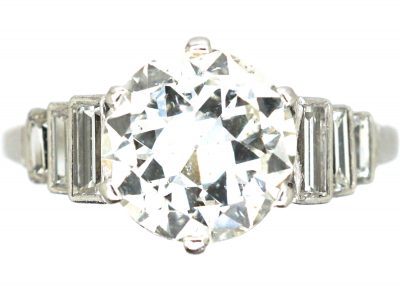 Art Deco Platinum, Transitional Cut Diamond Solitaire Ring with Step Cut Shoulders set with Baguette Diamonds
Art Deco Platinum, Transitional Cut Diamond Solitaire Ring with Step Cut Shoulders set with Baguette Diamonds
Another significant collection is that of Princess Diana, whose sapphire and diamond engagement ring, now worn by Catherine, Princess of Wales, remains one of the most famous royal jewels in the world. Princess Diana’s jewellery, much of which has been passed down to her sons, continues to captivate royal watchers and collectors alike.

In the modern era, royal jewels continue to be symbols of continuity and tradition. The British royal family, in particular, maintains one of the largest and most famous collections in the world, with pieces like the Cambridge Emeralds, the Imperial State Crown, and Queen Mary’s Lover’s Knot Tiara being worn by members of the royal family on state occasions.
-
 Edwardian 18ct & Platinum, Sapphire & Diamond Cluster Ring
Edwardian 18ct & Platinum, Sapphire & Diamond Cluster Ring -
 Edwardian 18ct Gold & Platinum, Sapphire & Diamond Cluster Ring
Edwardian 18ct Gold & Platinum, Sapphire & Diamond Cluster Ring -
 Early 20th Century Platinum, Large Sapphire & Diamond Oval Cluster Ring
Early 20th Century Platinum, Large Sapphire & Diamond Oval Cluster Ring -
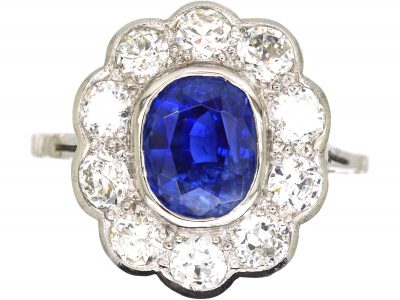 Early 20th Century Large Unheated Ceylon Sapphire & Diamond Cluster Ring
Early 20th Century Large Unheated Ceylon Sapphire & Diamond Cluster Ring -
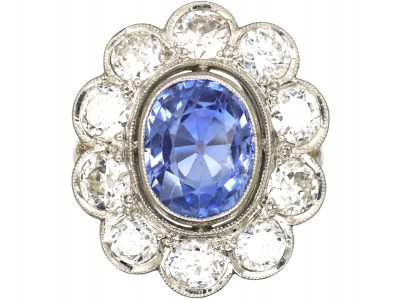 Early 20th Century French Platinum Large Sapphire & Diamond Cluster Ring
Early 20th Century French Platinum Large Sapphire & Diamond Cluster Ring -
 18ct Gold, Sapphire & Diamond Cluster Ring
18ct Gold, Sapphire & Diamond Cluster Ring

Conclusion
Jewellery has always been more than just adornment for the aristocracy; it is a reflection of power, wealth, and influence. From the ancient Egyptian pharaohs to the modern British monarchy, these collections tell the story of dynasties, political alliances, and personal relationships. The jewels of the aristocracy continue to fascinate and inspire, representing the ultimate symbols of status and style through the ages.
By tracing the evolution of royal and noble jewellery collections through history, we gain not only an appreciation for their beauty but also a deeper understanding of the social and cultural forces that shaped the world of the aristocracy. These jewels remain enduring symbols of power, legacy, and history, treasured by both their owners and the world.
Ready to build your own collection and begin a legacy?
We hold one of the world’s greatest collections of antique jewellery, available to purchase online. Choose from over 1,600 items or explore our archive of 15,000 stunning, historical pieces.
Read, watch, shop, learn – all in one place.



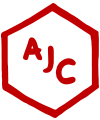 Free Worldwide Delivery
Free Worldwide Delivery View All
View All
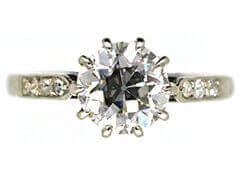 Diamond
Diamond
 Sapphire
Sapphire
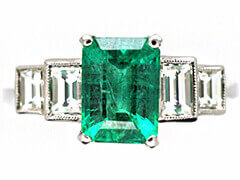 Emerald
Emerald
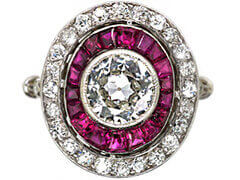 Ruby
Ruby

